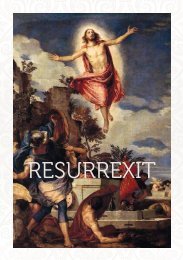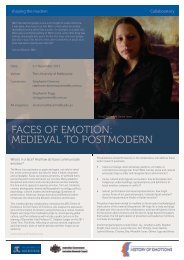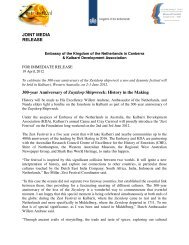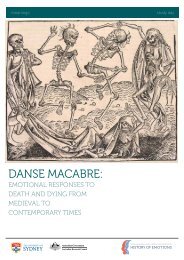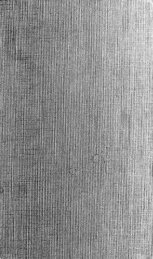Download our K-12 education pack - ARC Centre of Excellence for ...
Download our K-12 education pack - ARC Centre of Excellence for ...
Download our K-12 education pack - ARC Centre of Excellence for ...
Create successful ePaper yourself
Turn your PDF publications into a flip-book with our unique Google optimized e-Paper software.
stories <strong>for</strong> teachers & students 2013<br />
Supporting Res<strong>our</strong>ces<br />
South Africa, Far from Home<br />
stories by winthrop pr<strong>of</strong>essor susan broomhall<br />
Claiming spaces, knowing places:<br />
Fights and rights <strong>for</strong> land<br />
Europeans had laid claim to the Cape area from the time that the<br />
Portuguese explorer, Bartholomeu Dias, set foot ashore. At<br />
Kwaaihoek in 1488, he erected a stone column with a cross,<br />
known as a padrão, <strong>of</strong> St Gregory be<strong>for</strong>e turning back towards<br />
Portugal. This marked the land, in his mind, as a Portuguese<br />
claim in the name <strong>of</strong> Christians.<br />
Nine years later, it was clear that it was not just Vasco da Gama<br />
who understood the erection <strong>of</strong> padrões as European acts <strong>of</strong><br />
power. After da Gama had upset the local people by taking water<br />
from their water-holes without seeking permission, conflict<br />
ensured. Da Gama beat a hasty retreat to his ship but as they<br />
left, he looked back and saw ‘about 10 or <strong>12</strong> negroes overthrow<br />
both the cross and the padrão.’ The local peoples wanted nothing<br />
<strong>of</strong> the Europeans or their built remains.<br />
Europeans continued to build monuments to what were, <strong>for</strong><br />
them, conquests <strong>of</strong> new lands. João da Nova built a small chapel<br />
near Mossel Bay during his stay in 1501. This made it the first<br />
<strong>of</strong>ficial place <strong>of</strong> Christian worship in the area. They also marked<br />
their maps with names that reminded them <strong>of</strong> home, secured<br />
fav<strong>our</strong> with patrons, or echoed their religious beliefs. Among<br />
those that have remained from Portuguese times, is Natal (‘birth<br />
<strong>of</strong> Christ’), named by da Gama who arrived at this coast at<br />
Christmas time.<br />
These acts conveyed messages about how Europeans perceived<br />
the peoples who already lived in these places. They did not<br />
enquire about local names <strong>for</strong> the area, but gave them new ones<br />
that related to their own interests. Indeed, Europeans had great<br />
difficulty connecting with indigenous peoples at all. For example,<br />
they did not grasp differences between peoples, seeing the<br />
Khoikhoi and San people <strong>of</strong> Southern Africa as the same<br />
because both used click languages. When they wanted to<br />
communicate, Europeans did not learn indigenous languages.<br />
They instead took local people aboard their ships to new lands<br />
where they would be taught European languages.<br />
Early conflicts between indigenous peoples and Europeans<br />
erupted over the use <strong>of</strong> land. Even passing crews such as the<br />
Portuguese had caused anger to local peoples, because they<br />
drew water from precious water-holes used <strong>for</strong> people and herds<br />
without asking permission <strong>of</strong> the local owners. When the VOC<br />
established a colony at the Cape in 1652, these problems were<br />
made worse.<br />
The Goringhaiquas and Gorachouqua who lived in the area <strong>of</strong> the<br />
Cape peninsula that was most immediately impacted by<br />
European settlement, could see their pastures and water access<br />
quickly disappearing. Autshumato, a leader among the<br />
Goringhaiquas, who also acted as a translator, protested to van<br />
Riebeeck. He was known as Harry de Strandloper (Harry the<br />
Beachcomber) by the Dutch, a name which showed how<br />
disinterested the Europeans were to understand local identities<br />
and cultures. It was easier to give indigenous people Dutch<br />
names that they were familiar with, than learn those they used<br />
themselves. The VOC commander van Riebeeck wrote in his<br />
diary in 1656 how ‘Harry maintained that the land <strong>of</strong> the Cape<br />
belonged to him and the Kaapmans [Capemen, the Dutch name<br />
<strong>for</strong> the Goringhaiquas] but he was told that [as] the Company<br />
also required pasturage … his claim to ownership <strong>of</strong> this Cape<br />
could not be entertained.’<br />
For van Riebeeck, this was the end <strong>of</strong> the matter, but not so <strong>for</strong><br />
the Goringhaiquas. Autshumato began to steal cattle from the<br />
Dutch, by whom he felt he had been cheated. In 1658 van<br />
Riebeeck ordered that he was to be placed as punishment on<br />
Robben Island. Autshumato escaped on a rowboat after 18<br />
months. But life had changed <strong>for</strong>ever <strong>for</strong> the Goringhaiquas.<br />
Autshumato eventually sought permission from the new VOC<br />
commander, Zacharius Wagenaer, to return to his homeland<br />
–now the Cape Colony – and to continue his work as an<br />
interpreter between his people and the Europeans. Resistance to<br />
the VOC rule had failed, perhaps negotiation from within would<br />
be more successful.<br />
IMAGE/ The battle <strong>of</strong> Goringhaiqua and the death <strong>of</strong> Almeida, 1510, by Angus McBride, 1984. C<strong>our</strong>tesy Castle Military Museum<br />
FAR FROM HOME: ADVENTURES, TREKS, EXILES & MIGRATION<br />
35





